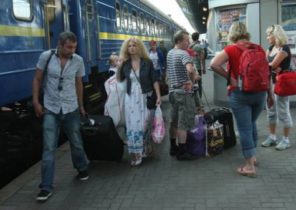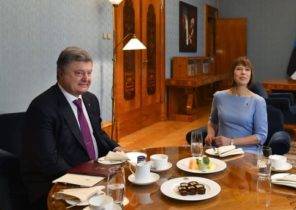The Russian approach to the Baltic States sometimes seem to be as imminent a seizure.
This view became especially pronounced after the annexation of the Crimea by Russia in 2014, when other neighbouring countries began to Express concern about the fact that they can get into the field of view of Russia. In fact, Russia is hardly interested in territorial conquests in the Baltic countries, and last but not least this is because such steps could lead in effect to Article 5 of the NATO Charter, the principle of collective defence.
It should take into account that Russia is unlikely to win the conflict with the NATO allies. In addition, as shown by some polls, the conflict near Russia’s borders may not get the full support of the Russian population. For example, data held in 2017, the independent Levada Center, which studies public opinion showed a drop in support of Russia’s participation in other border conflicts, including the conflict in Eastern Ukraine. However, the results of a recent survey conducted by the Russian center for public opinion studies (VTSIOM) show that 71% of respondents support the proposed amendment to the Constitution, which States that the Russian leadership is responsible for the protection of compatriots abroad.
However, Russia has many other tools to be more effective than covert or open military aggression, to exert influence on the Baltic States. A significant part of the population in these countries consists of ethnic Russians, as well as the ongoing dependence on Russian energy allows Moscow to maintain its status as the most influential shareholder.
Russian just go, or are they already here?
Of course, there is another dimension to security in the Russian approach to the Baltic States. Russia considers them an important place for the gathering of intelligence needed to understand existing capabilities of NATO and exchanges of spies on both sides there quite often, evidence of ongoing intelligence operations.
The Baltic States, for its part, expressed concern over the placement of Russian weapons and troops near its borders with Russia, and also about the building of Russia’s Arsenal, including the modernisation of facilities to store weapons in Kaliningrad, the Russian exclave. Russia has recently built up its military capabilities in the Western military district, including the border areas with the Baltic States and deployed additional anti-aircraft missile regiment in the structure of the air defense forces.
There is also evidence that Western military district has upgraded some of its tactical capabilities, and restore the 1st guards tank army in the region, which has at its disposal main battle tanks and is the first new Russian tank army, formed after 1991. In addition, the headquarters of the Russian Baltic fleet is at Kaliningrad region bordering the Baltic States. The Navy conducts exercises, and is also often used as a training war games. The last of these games was held in June 2020, and it coincided with their own maneuvers with NATO BALTOPS.
Russia is also conducting large-scale maneuvers with Belarus (in 2017 was held an exercise called “West”), part of which took place on the territory of Belarus, which caused concern in neighboring Lithuania. Russia, in turn, expressed dissatisfaction with the NATO presence in the Baltic States, and its planes constantly approaching aircraft and ships of NATO to measure the time of their response.
In addition to the deployment of weapons and his demonstrations in its own territory, bordering with the Baltic States, Russia also maintains contacts with Russian-speaking communities in these States, and the Kremlin, of course, considering these people as your asset in the framework of implementation of the strategy to maintain influence in the Baltic region. Latvia has the greatest number of people who consider themselves Russian (35% of the population), whereas in Estonia the number of Russian is 29%, and in Lithuania their less — about 6%. Question about the owners of grey passports to ethnic Russians in Latvia and Estonia do not receive automatic citizenship after the collapse of the Soviet Union — is an obstacle to progress in the field of integration of Russian-speaking community in these countries. Moscow took advantage of the existing problems and presents himself as a defender of Russian-speaking people in the region. In addition, Russia criticized Estonia and Latvia for the fact that they did not provide automatic citizenship to members of the many Russian-speaking minorities. Moscow also stressed that all three Baltic States adopted restrictive laws, the purpose of which is to reduce public use of the Russian language.
It’s the economy, asshole
Undoubtedly, the Kremlin strategists believe Russia’s status as a major trading partner of all three Baltic States is another reliable tool in your Toolkit to maintain influence in the region. Although the supply of Estonia to Russia decreased by EUR 63 million in 2019, Latvia, Russia remains an important export destination, which in value terms amounted to 9.2% for its market in 2019. As for Lithuania, Russia is also one of the main export partners, and its market share is 13.4%. Total trade of the Baltic countries with Russia decreased in the period from 2013 to 2019. According to the International monetary Fund, in 2013 the total volume of trade between Russia and Latvia amounted to 11.2 billion dollars (19-th place in the list of trading partners of Russia). In 2019, the volume of trade declined by more than two times and amounted to 5.4 billion dollars, and Latvia as a result fell back to 25th place in the list of trading partners of Russia. In the same period, Lithuania has dropped on this list from 25 to 34 place among trading partners of Russia (total trade volume was 4.1 billion dollars), while Estonia dropped from 30th place to 40th ($2.9 billion).
Energy supplies make up a significant portion in the trade of Russia with the Baltic countries. As for the oil in the first half of 2019 Estonia and Lithuania imported more than 75% of its oil from Russia, while Lithuania imported a much smaller amount of oil from Russia — only 25% of its oil imports accounted for Moscow. In addition, the Baltic countries previously imported from Russia a large part of the consumed natural gas. For example, in the first половине2019 year, Estonia and Latvia has purchased more than 75% of natural gas from Russia, while the figure for Lithuania amounted to 50-75%. In addition to the sale of natural gas to the Russian company Gazprom in 2013, owned large stakes in major gas companies of the Baltic States – 37% of the Lithuanian company Lietuvos Dujos, 47% of the Estonian company Eesti Gaas and 50% of the Latvian company Latvijas Gaze. This gave the Gazprom, and, consequently, Russia, a significant voice in determining policy in the field of natural gas the Baltic States.
However, in recent years, the stakes of Gazprom in local gas companies was reduced. In 2016, the Estonian company Trilini Energy bought the stake of Gazprom in the company Eesti Gaas and Gazprom’s share in the company Latvijas Gaze dropped to 34% and, in addition, in 2014 the company was sold to Lietuvos Dujos, after a dispute regarding compliance with antitrust legislation. In addition, Gazprom is no longer the only Russian player in the regional energy market — for example, the Estonian company Eesti Energia buys natural gas from NOVATEK, a private Russian gas company, and shipped via the Lithuanian port of Klaipeda, which means that the participation of Russia in this sector is still welcome.
In addition to reducing the impact of Gazprom in the region, the Baltic States are also trying to reduce its dependence on supplies of Russian electricity is a relic of the days of the Soviet Union, when Moscow was ruled by the Central energy system the Unified energy system of the country. Their dependence on the electric ring BRELL (Belarus, Russia, Estonia, Latvia, Lithuania) continues to exist though the Baltic States have argued that their dependence on Russian energy supplies poses a threat to their national security. The Baltic States are concerned that Russia may disconnect them from the network, thus isolating their own electrical network. As an example, they cite an episode that took place in may 2019, when Russia briefly cut off power transmission lines connecting Kaliningrad and Lithuania in the framework of the planned three-day test. However, before that Russia did not cut off the Baltic countries from the mains, and although in the past, Russia temporarily stopped the supply of natural gas to some countries in response to political differences, she never used for these purposes, the supply of electricity. This means that the concern of the Baltic States on this issue may be to some extent exaggerated.
In response to a perceived threat to the national security of the Baltic countries began to achieve success in the process of separating their electric grids from Russia. In 2018, the Baltic States and Poland have reached an agreement on the supply by the year 2025 the electricity in those three States from the EU. The transmission line between Lithuania and Poland (LitPol) and the transmission line between Sweden and Lithuania (Nordbalt) provide deeper integration with the European electricity grid. Vladimir Putin criticized the decision, which, he said, can cause “certain areas between certain territories of the Russian Federation, where we have lines of electricity transmission”. Though he did not say this openly, however, the process of decoupling will also reduce Russian influence in the region, and at the same time you should also consider the application of Estonia that it will no longer buy electricity from Russia.
It should be noted that the Baltic countries are not United in their approach to Russia as a whole. Lithuania has a contract with Gazprom until 2025 concerning the gas transit through Kaliningrad, and Latvia, whose budget depends on payment of transit of gas, is keen to maintain a certain level of cooperation with Russia, if this move will affect local revenues. Although Estonia is officially a tougher stance against Russia and has with it fewer trade links than Latvia and Lithuania, many large Russian companies operate in Estonia and use the advantages of easy process online registration and designed to assist in the creation of new companies. Was also charged regarding the fact that in the period from 2007 to 2015, some companies associated with the Russian Federal security service (FSB), laundered money through located in Estonia branch of the Danish Bank Danske Bank, which became possible due to a lack of strict control of the financial system in that period.
Russia reduces its own dependence on the Baltic States
The change in economic relations of Russia with the Baltic countries, apparently, is to some extent a reflection of its own concerns about their own economic security. Russia seeks to avoid dependence on trade from those countries that are NATO members, and does not suit her dependence on Baltic ports in the process of implementing freight transport. As the price of oil, of which depend on the quotes of the ruble remains at a low level, and the expected economic growth in 2021 will amount to only 1.8%, Russia is becoming more reluctant to pay the Baltic States for the use of their ports to export its oil.
This shift began after the annexation of Crimea, when Russia began to give preference to the direction of cargo flows through its own ports, which makes countries such as Belarus and use Russian ports. Reduction of Russian oil export and tranship coal using almost all Baltic ports have had a significant impact on the Baltic States because they lost the income from transit. The turnover of all the Baltic ports decreased. In the first half of 2019, the transit of Russian goods through the ports of the Baltic States dropped by 12.4%, but it increased through the Russian ports located in the Gulf and elsewhere in the Baltic region. In 2020 through Russian ports in this region was transported 110,9 million tons of cargo. Railway network in the Baltic countries also felt the impact of these changes, since they usually depended on Russian cargo.
Russia seems to be determined and will change their trade routes, investing in the business heavily. Currently under construction of a new oil terminal in Primorsk located in Leningrad region, and in accordance with existing plans, it will begin its work in 2020. Through this port will be carried out all traffic that previously went via the ports of the Baltic States, and there will establish a major Russian export terminal, which will deal with handling of coal and grain. In addition, Russia could use the existing port in Ust-Luga. It is located in the Gulf of Finland and is one of the deepest in the Baltic region. The port in Ust-Luga capable of handling per year 180 million tons of cargo, but in the period from January to November 2019, its turnover amounted to 95.3 million tonnes, and this means that it is not yet being used at full capacity.
The construction of ports, especially deep water, is expensive, and these investments are projected to amount to 90 billion rubles, which means that Russia considers this long-term project. However, current pressure on the state budget and the lack of private investment in the Russian ports can cause the project to be delayed.
Russia is still in the game
The Baltic country has undoubtedly made significant progress in diversifying their trading, including in the field of energy imports, and moved in this respect from Russia. Moscow also has taken steps to reduce its own dependence on the Baltic States in the field of transit of its energy exports and other goods. Despite all these efforts aimed at reducing interdependence, Russia continues to maintain a significant influence in the Baltic region — it continues to remain a key energy supplier and a major trading partner.
Will continue until it is based on numerous factors influence (to this should be added the membership of the Baltic States into NATO), will remain a low probability that Russia will decide to use in this region of intervention in the style of the history of the Crimea. Although Russia wants to maintain its influence in the Baltic region, it may get more, if will use non-military methods. So it is unlikely that such a scenario in which the Baltic States will become another hot spot in us-Russian relations, as happened with the conflict in Ukraine.







